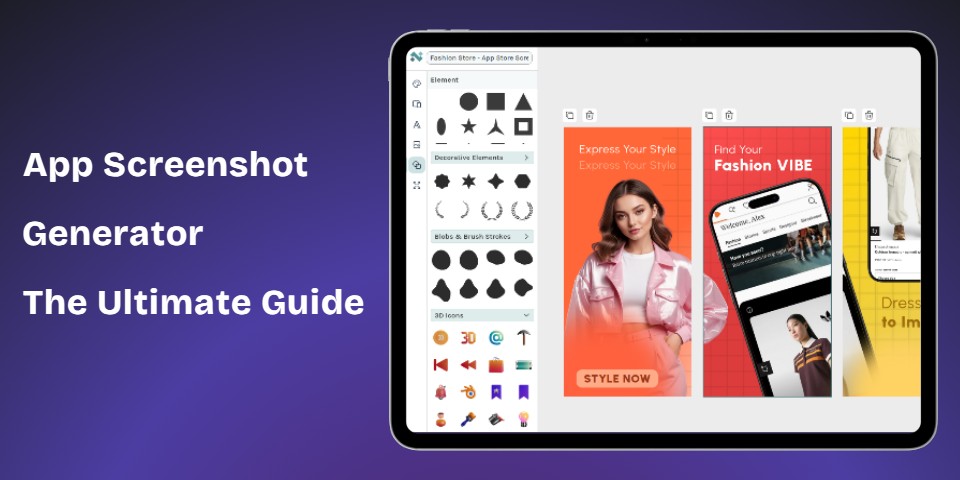
App Store Screenshot Generator: The Ultimate Guide for Better Downloads (2025)
Did you know that only 2% of users click the “Read More” button to learn more about an app? Screenshots are the silent salespeople of your App Store and Play Store listing, and the right App Store screenshot generator can transform your download rates. The proof is in the numbers—companies like FiftyThree saw a remarkable 33% increase in downloads after optimizing their app screenshots.
Screenshots play a vital role in App Store Optimization (ASO). Creating professional, eye-catching screenshots for different devices and markets can be challenging. This piece will guide you through the best screenshot tools and practices.
Nakxi helps you create appstore / playstore screenshots that turn impressions into downloads.
Define Your Screenshot Goals First
Let’s set clear goals for your App Store or Play Store screenshots. App Store/Play Store users spend just 7 seconds on a product page [1]. You need to make every second count to showcase your app’s value.
We focused on choosing what to highlight first in our set of templates. Studies show all but one of these users view all available screenshots [1]. Your first three or four images should highlight your app’s core features and main selling points.
Your screenshots should balance common features with unique selling points that set you apart from competitors [2]. This balance is vital for standing out in busy app stores. The screenshots need to tell your brand’s story cohesively instead of showing random features [1].
Technical requirements deserve early attention in your planning phase:
- Different device types need different screenshots. Apple has specific size requirements for iPhone and iPad models [3].
There’s another reason to define your presentation style early. You’ll need to decide between showing your app in ground situations or focusing on the interface. Tools like **Nakxi help create realistic mockups. Their pricing ranges from free versions with watermarks to $9.99 monthly subscriptions.
Testing should be your top priority. Users judge apps quickly based on visuals rather than descriptions [4]. A/B tests are a great way to get insights about different screenshot designs. Apple and Google both provide native A/B testing tools to track which visuals drive more downloads [5].
Setting these goals before generating screenshots helps you save time and avoid mistakes [2]. You’ll create visuals that boost downloads instead of just looking good.
Why Choose Nakxi as Your App Screenshot Maker
Your app store screenshot generator choice can make or break your conversion rates. Research shows that 70% of users decide to download based on visuals alone according to Nakxi’s research.
The first thing to think about is your budget. Free tools like AppScreens let you create simple screenshots. These tools work well but have limits on design choices and customization. Paid options give you better features and support, which leads to more professional results.
Nakxi lets you create one free project where you can choose an unlimited number of assets and start from your favorite ready-made templates.
How easy the tool is to use matters a lot.
- Canva’s easy-to-use interface works great for beginners.
- Tools like Figma need more design skills, but give you better customization options.
Here’s what to look for when comparing screenshot tools:
- Template variety: Nakxi gives you 100+ templates to customize [7].
- Device compatibility: The tool should support 35+ devices [8] on both iOS and Android.
- Export options: Nakxi helps you resize for all store dimensions at once, saving you hours of work [9].
Nakxi stands out with its pre-built layouts that make creating templates quick and easy. Canva is a solid free option, especially for mobile templates, but it has limitations—it doesn’t support horizontal screen or template design, and you can’t share a frame across multiple artboards.
Best Practices to Generate Screenshots for App Store
Beautiful app store screenshots need the right tools and smart implementation of proven methods. The first three screenshots get maximum visibility according to research [10]. My strategy puts the most captivating visuals right at the start of the sequence.
Visual elements must stay consistent. My process with app store screenshot generators focuses on these key elements:
- Device frames (they provide context)
- Color palette (aligned with app branding)
- Typography and text placement
- Layout structure and orientation
Device frames play a vital role by helping users see your app in a real-world context [10]. In most screenshots, iPhone, Android, and iPad apps benefit from device frames. The first screenshot works better with social proof—this is the only exception [10].
The App Store lets you add up to 10 screenshots per listing [11]. Using more than 6 screenshots can boost conversion rates based on testing data [12]. Portrait screenshots deliver better results for most apps, while games typically use landscape orientation [13].
A/B testing helps optimize your screenshots—both Apple and Google provide built-in testing features [14]. Research shows that reducing text from 8–10 words to just 3–4 per screenshot substantially improves performance [10].
Google Play’s limit of 8 screenshots differs from Apple’s 10 [15]. Plan your visual story carefully when using screenshot generation tools for both platforms.
Conclusion
App screenshots are powerful conversion tools, yet many developers underestimate their effect on success. My experience with screenshot generators and market data analysis shows how strategic screenshot creation directly boosts download rates.
Creating successful app store screenshots needs three essential elements:
- Clear goals
- The right tools
- Solid execution
Smart developers don’t rush to create visuals. They begin with defined objectives and choose screenshot generators that match their specific needs. They also follow proven best practices during implementation.
Screenshot optimization requires continuous attention. Market trends change, user priorities evolve, and new devices emerge. Your conversion rates will stay strong when you test different approaches, analyze results, and adapt to changes. Your app’s unique story should shine through visuals that connect with target users.